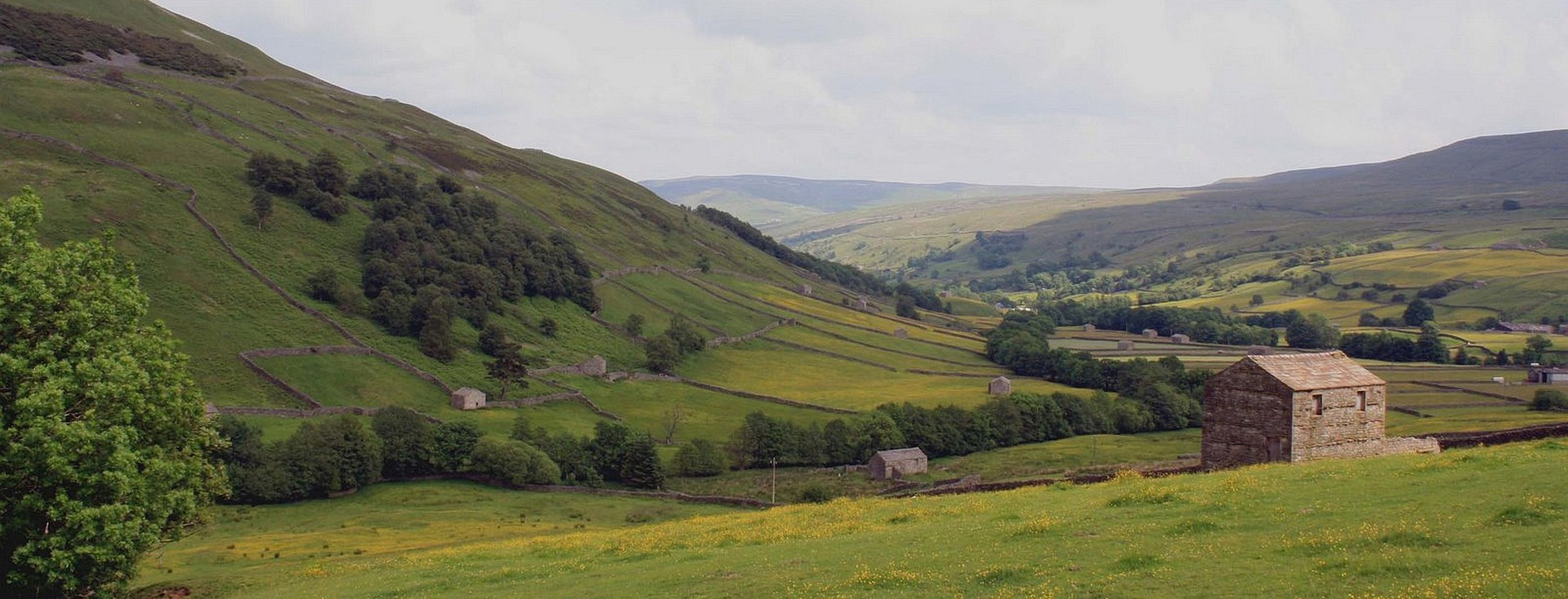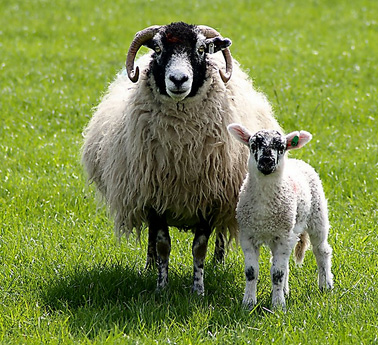
Grid Ref: – SD 97636 98304
Swaledale, a captivating valley in the Yorkshire Dales National Park, is a place where history whispers from ancient stone walls, and natural beauty unfolds at every turn. This northern dale, characterized by its rugged terrain, verdant pastures, and meandering river, encapsulates the essence of rural England. Key locations such as Reeth, known for its large village green, act as hubs for exploring the surrounding landscape. Muker and Gunnerside offer glimpses into traditional Yorkshire life, with their stone-built cottages and narrow winding lanes. The area is crisscrossed by a network of footpaths and bridleways, leading to hidden waterfalls and vantage points offering breath-taking views. Swaledale’s wildflower meadows, particularly glorious in late spring and early summer, are a testament to the rich biodiversity that thrives in this less-travelled part of the Dales.
Importance of History and Culture in Understanding the Region
Delving into the history and culture of Swaledale enriches one’s appreciation for the dale beyond its scenic beauty. The tapestry of Swaledale’s past is woven with threads of Norse and Celtic influences, evident in place names and local dialect. The region’s agricultural heritage, marked by sheep farming and the iconic Swaledale wool, speaks to a deeply rooted relationship between the people and the land. Festivals and traditions, such as the annual Swaledale Festival, celebrate the rich cultural life that has evolved in this secluded valley. Understanding the historical context and cultural fabric of Swaledale opens a window to the soul of the Yorkshire Dales, offering insights into the resilience and creativity of its communities.
Swaledale’s population is a blend of long-standing families and newcomers drawn by the dale’s tranquillity and beauty. The community is sustained by a mix of agriculture, tourism, and small businesses, including artisan crafts and local produce. Traditional sheep farming remains a cornerstone of the rural economy, with local breeds such as the Swaledale sheep being a common sight. The rise of tourism has led to the growth of hospitality jobs, from quaint bed and breakfasts to country pubs. Artisans and craftspeople also contribute to the local economy, with galleries and workshops showcasing everything from pottery to textiles, inspired by the landscape of Swaledale.
The Chronicles of Swaledale: Echoes of the Past
Early Settlements and Evidence of Prehistoric Inhabitants
Swaledale’s history stretches back thousands of years, with evidence of prehistoric inhabitants shaping the landscape. Archaeological findings, such as ancient field systems and burial mounds, provide a glimpse into the lives of these early settlers. The dale’s natural resources, including fertile land and abundant water, made it an attractive location for Neolithic and Bronze Age communities. These early inhabitants left behind stone circles and other megalithic structures, silent sentinels bearing witness to Swaledale’s ancient past.
Influence of Roman Occupation on the Region
The Roman occupation of Britain left an indelible mark on Swaledale, as seen in the remnants of Roman roads that traversed the region. The Romans exploited the dale’s mineral wealth, particularly lead, which was abundant in the area. Evidence of Roman mining operations and settlements indicates a period of significant economic activity and cultural exchange. The strategic importance of Swaledale in controlling the northern territories is underscored by these archaeological discoveries, highlighting the region’s role in the broader tapestry of Roman Britain.
Development of Mining and Agriculture in Swaledale
The twin pillars of Swaledale’s historical economy—mining and agriculture—have shaped the landscape and community life for centuries. The extraction of lead became a major industry following the Roman period, reaching its zenith in the 18th and 19th centuries. This mining heritage is etched into the dale’s topography, with the ruins of old smelt mills and miners’ cottages dotting the landscape. Parallel to mining, sheep farming and agriculture have sustained Swaledale’s inhabitants, moulding the patchwork of fields and meadows that define the dale’s appearance. The resilience of these industries, despite the challenges of geography and market fluctuations, testifies to the enduring spirit of the Swaledale community.
The Cultural Tapestry of Swaledale
Traditional Industries and Crafts Unique to the Area
Swaledale’s cultural heritage is rich with traditional industries and crafts that have endured through the ages. Wool production, stemming from the hardy Swaledale sheep, has been a staple of the local economy, giving rise to knitting and weaving traditions that are celebrated to this day. The craft of dry stone walling, essential for managing the landscape and livestock, is another skill that has been passed down through generations. These crafts are not only economically significant but also embody the deep connection between the people of Swaledale and their environment.

Influence of Norse and Celtic Cultures on Local Traditions
The cultural landscape of Swaledale is deeply influenced by Norse and Celtic heritage, reflected in the region’s folklore, music, and festivals. Norse settlers, arriving in the early medieval period, left a linguistic legacy in place names and the local dialect. Celtic traditions, predating the Norse presence, continue to permeate local customs and beliefs. The fusion of these cultures is evident in the unique character of Swaledale’s festivals and community gatherings, which blend music, dance, and storytelling in a celebration of the dale’s rich history.
Role of Historic Buildings and Landmarks in Preserving the Region’s Cultural Identity
Swaledale is dotted with historic buildings and landmarks that serve as custodians of the region’s cultural identity. Medieval churches, ancient bridges, and centuries-old farmsteads tell the story of a community that has adapted to the challenges of time while preserving its heritage. These structures are not merely relics of the past but active participants in the life of the dale, hosting events, services, and meetings. The conservation of these landmarks is a testament to Swaledale’s commitment to safeguarding its cultural legacy for future generations.
Navigating Modern Influence on Swaledale
Impact of Tourism on Local Economy and Culture
The beauty and tranquillity of Swaledale have attracted increasing numbers of visitors, bringing both opportunities and challenges to the local community. Tourism has become a vital part of the economy, supporting businesses and creating jobs. However, the influx of visitors also raises concerns about preserving the natural landscape and maintaining the dale’s unique character. Balancing the benefits of tourism with the need for sustainability is a key issue facing Swaledale, as it seeks to welcome the world while protecting its heritage.
Conservation Efforts to Protect the Natural Landscape and Heritage Sites
Conservation efforts in Swaledale are focused on protecting the natural landscape and heritage sites that define the region. Initiatives such as habitat restoration, sustainable farming practices, and the preservation of historical buildings are central to these efforts. The involvement of local communities, conservation organisations, and government agencies highlights a collective commitment to stewardship of Swaledale’s environmental and cultural treasures.
Challenges Faced by the Community in Preserving Their History and Culture
The community of Swaledale faces ongoing challenges in preserving its history and culture in the face of modern pressures. Economic changes, demographic shifts, and environmental concerns all pose threats to the traditional ways of life. Addressing these challenges requires innovation, collaboration, and a deep respect for the past. The people of Swaledale are engaged in a delicate balance, striving to maintain their cultural identity while adapting to the evolving demands of the 21st century.
The journey through Swaledale’s past and present invites a call to action for the continued preservation and appreciation of the region’s heritage. It is a collective responsibility to safeguard this unique legacy for future generations. By supporting conservation efforts, celebrating traditional culture, and engaging with the local community, visitors and residents alike can contribute to the enduring story of Swaledale.
Let us cherish and protect this remarkable part of the Yorkshire Dales, ensuring its history, beauty, and cultural richness remain vibrant for years to come.
Citations
Data and insights for this article were informed by resources available up to April 2023, including the official Yorkshire Dales National Park website (yorkshiredales.org.uk), historical records, and cultural studies relevant to Swaledale and the wider Yorkshire Dales area.
